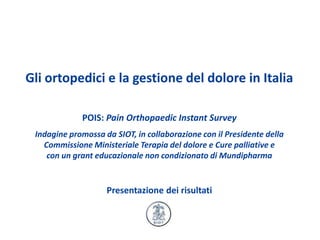
Gli ortopedici e la gestione del dolore in Italia
- 1. Gli ortopedici e la gestione del dolore in Italia POIS: Pain Orthopaedic Instant Survey Indagine promossa da SIOT, in collaborazione con il Presidente della Commissione Ministeriale Terapia del dolore e Cure palliative e con un grant educazionale non condizionato di Mundipharma Presentazione dei risultati
- 2. POIS - Pain Orthopaedic Instant Survey pag. 2 Aspetti metodologici Modalità interviste: questionario di 10 domande somministrato online, con accesso tramite password Timing instant survey: 17 ottobre 2012 Campione: 101 ortopedici, afferenti ad altrettante strutture ospedaliere di tutta Italia Redemption Ortopedici coinvolti nell’indagine: 143 29,4% Redemption 70,6% Assenza di Ortopedici aderenti: 101 risposta Quasi ¾ degli Ortopedici coinvolti hanno aderito 0 50 100 all’indagine Campione (%)
- 3. POIS - Pain Orthopaedic Instant Survey pag. 3 Carta di identità del campione Area geografica Reparto Sud e Isole 30,7% Traumatologia dell'Apparato locomotore 1% 1% Traumatologia Centro 19,8% Ortopedia delle Articolazioni 1% Nord 49,5% Chirurgia dell'Apparato locomotore 1% Poliambulatorio 1% 0 10 20 30 40 50 60 Ortopedia e Traumatologia 45,5% 1% Anestesia e Rianimazione Ortopedia 48,5% 0 10 20 30 40 50 60
- 4. POIS - Pain Orthopaedic Instant Survey pag. 5 Alcuni risultati
- 5. POIS - Pain Orthopaedic Instant Survey pag. 6 La conoscenza della Legge n. 38 del 15 Marzo 2010 sulla terapia del dolore
- 6. POIS - Pain Orthopaedic Instant Survey pag. 8 Il grado di conoscenza della Legge n. 38 sulla terapia del dolore Domanda - La Legge fa un esplicito riferimento all’obbligo di riportare la rilevazione del dolore in cartella clinica? Sì 0% Non ricordo 28,7% 10,9% No (0%) 60,4% 89,1% Sì, ma non ricordo il n. dell'articolo Sì e ricordo il n. dell'articolo L’obbligo di annotare in cartella clinica la rilevazione del dolore è noto a una percentuale elevatissima di intervistati. Tra questi, circa il 60% ricorda anche il numero dell’articolo di Legge
- 7. POIS - Pain Orthopaedic Instant Survey pag. 9 Il grado di conoscenza della Legge n. 38 sulla terapia del dolore Domanda - La Legge fa un esplicito riferimento all’obbligo di riportare in cartella clinica anche i farmaci utilizzati, i relativi dosaggi e il risultato antalgico conseguito? 4,9% Sì Non ricordo 28,7% 18,8% No 76,3% 47,6% Sì, ma non ricordo il n. dell'articolo Sì e ricordo il n. dell'articolo L’obbligo di riportare in cartella clinica anche le informazioni sui farmaci somministrati e il risultato antalgico conseguito è noto a un’elevata percentuale di rispondenti. Tra questi, circa il 47% ricorda anche il numero dell’articolo di Legge
- 8. POIS - Pain Orthopaedic Instant Survey pag. 11 La conoscenza della scala NRS per la valutazione del dolore
- 9. POIS - Pain Orthopaedic Instant Survey pag. 12 La conoscenza della scala NRS per la valutazione del dolore Domanda – Qual è, secondo la scala NRS, il valore oltre il quale il dolore è definito severo? Non ricordo >7 32,6% Lo ricordo sbagliato 41,6% >3 46,5% >4 4% >5 6,9% 11,9% >6 76,3% 1% 1% 1% >8 > 10 Il 58,4% circa degli intervistati non conosce la classificazione del dolore secondo la scala NRS, sebbene la maggior parte di essi indichi un valore (> 6) che si discosta dal valore corretto solo di una unità
- 10. POIS - Pain Orthopaedic Instant Survey pag. 13 La prescrizione dei farmaci per il dolore
- 11. POIS - Pain Orthopaedic Instant Survey pag. 14 La prescrizione dei farmaci per il dolore Domanda – Per il dolore severo osteoarticolare quale farmaco prescrive con maggiore frequenza? FANS 24,7% 25,7% Inibitori COX2 Paracetamolo da solo o 10% in associazione 20,8% Oppiacei deboli 18,8% Oppiacei forti Per il dolore severo osteoarticolare, i farmaci prescritti con maggiore frequenza sono i FANS, benché in questi casi il ricorso agli antinfiammatori non steroidei non sia previsto da Linee Guida
- 12. POIS - Pain Orthopaedic Instant Survey pag. 16 La prescrizione dei farmaci per il dolore Domanda – Se in un paziente con dolore severo non prescrive oppiacei, qual è il motivo principale? 7,9% Non sono indicati 29,7% Effetti collaterali Non conosco la farmacocinetica 1% 61,4% Resistenza da parte del paziente La ragione principale che scoraggia gli intervistati a prescrivere i farmaci oppiacei è legata al timore di effetti collaterali
- 13. POIS - Pain Orthopaedic Instant Survey pag. 18 La prescrizione dei farmaci per il dolore Domanda – Quale effetto collaterale teme maggiormente nel caso di somministrazione di oppiacei? 0% 23,8 Prurito (0%) 48,5% Disorientamento Stipsi 27,7% Nausea/vomito La nausea e il vomito risultano essere gli effetti avversi maggiormente temuti dagli intervistati, seguiti dalla stipsi
- 14. POIS - Pain Orthopaedic Instant Survey pag. 19 L’interesse a perfezionare la propria conoscenza sulla gestione del dolore
- 15. POIS - Pain Orthopaedic Instant Survey pag. 20 L’interesse nei confronti del tema Domanda – Sarebbe interessato a partecipare a Corsi di Formazione sul Dolore? 9,9% 13,9% Sì No 76,2% Non saprei Un’elevata percentuale di intervistati afferma di voler approfondire le proprie conoscenze in tema di gestione del dolore attraverso Corsi di Formazione
